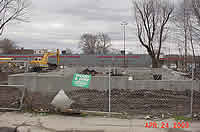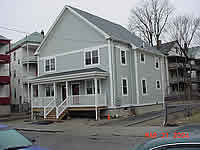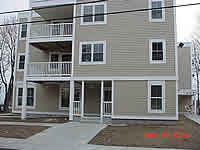Waste Site Cleanup & Reuse in New England
New Community Brings the Elderly and Foster Children Together, Keeping "Boston's Hope" High
Boston’s Hope Project Cleans Up 22 Properties to Make Way for Quality Housing using EPA Brownfields Funding and a Tax Incentive Program
Success in the EPA Targeted Brownfields Assessment Grant Program
Dorchester, MA
(April 5, 2004)
Contacts
The face of one Boston’s neighborhood is forever changed. Where trash and weeds once littered the ground, landscaped yards and beautiful apartments now stand. Young children run across green lawns to visit their new foster grandparents who are always just a block away. The neighborhood that was once home to 23 abandoned or demolished buildings is now home to young children, their new foster families, and their new “grandparents.” This revolutionary intergenerational neighborhood is called Boston’s Hope and its $31 million transformation was made possible in part by a US EPA Targeted Brownfields Assessment grant, a federal brownfields tax deduction program, and a partnership between the Home for Little Wanders, a social service agency for families and children and the Boston Aging Concerns Young & Old United, Inc. (BAC-YOU) an organization that finds housing for a growing number of homeless seniors.
The properties that make up the new Boston Hope neighborhood are spread across the northern section of Franklin Field in Dorchester. Historically, the properties were residential buildings built between 1967 and 1985. The properties were abandoned and destroyed when the city of Boston acquired them in the 1990s. Only a single-family dwelling at 219 Harvard Street built circa 1900 was left, boarded up and charred following an earlier interior fire. The undeveloped plots were purchased from the city by BAC-YOU in 1999 following an environmental site assessment on all the properties.
The site assessment was made possible due to a US EPA Targeted Brownfields Assessment grant of $105,000. With this grant, the city and BAC-YOU were able to afford the costly task of evaluating environmental contamination within the site and determining what the cost of cleanup would be.
The EPA site assessment activities, which were completed in December 2001, revealed that the over 90,000 square feet of unutilized property contained a fuel oil above ground storage tank, soil contamination including the presence of lead, and multiple sites with solid wastes including tires, abandoned cars and other trash. Armed with the site assessment information, the city and BAC-YOU were able to begin the long road to site cleanup.
Final cleanup costs for the new Boston’s Hope project total approximately $293,000 to date. Through the Federal Brownfields Tax Incentive Program, BAC-YOU, the developer for the project, will be able to deduct any expenses that they incurred during the cleanup from their income taxes. This important program helped the organization reach the Massachusetts residential cleanup standards needed to prepare the once contaminated properties for residential redevelopment.
Today, the project is in its final stages of construction with a planned opening date of April 1, 2004. The project will encompasses 41 new and affordable apartments. The apartments will be home to 30 seniors, 10 families and their foster children between the ages of 6 and 12. The center will contain computers, games, and large meeting areas to allow for group dinners and meetings between foster families and their new grandparents.
Having the seniors and foster children together offers members of the revolutionary Boston’s Hope a sense of community and gives the once neglected children the opportunity to experience life in an extended family situation, complete with the love and mentoring of foster grandparents. The Boston’s Hope neighborhood gives foster children and their willing, but low-income guardians and foster grandparents, a new sense of community, quality and affordable housing, and the opportunity to develop familial relationships that will last a life time. This important new community will open its doors on June 2, 2004 with a ribbon cutting ceremony.





